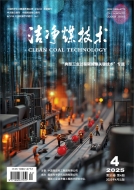Effect of associated minerals in Zhundong high-iron coal on theapparent properties of coal water slurry
 2024 No. 06
2024 No. 06
 1030
1030 308
308

Citation format:

Authors:
- LIU Xiaotian
- WANG Shan
- WEN Rongrong
- XU Yanfeng
- GAO Haoyang
- WEI Bo

Unit:
- Key Laboratory of Coal Clean Conversion & Chemical Engineering Process, School of Chemical Engineering and Technology,Xinjiang University

Abstract:
The Zhundong Heishan mining area, particularly the Jiangjunmiao No.2 mine, is abundant in high iron coal reserves, a sourceof high-quality power coal. The impact of primary associated minerals in coal on the performance of coal water slurry was focused on,using these coal samples. The samples, varying by mineral content, type, and distribution rule, were divided into different density gradesvia the coal flotation and sedimentation separation method, facilitating an evaluation of their influence on slurryability. Energy dispersivespectrometer (EDS), X-ray diffraction (XRD), and X-ray fluorescence (XRF) were utilized to pinpoint the elemental content and mineral composition in the samples. Correlations between different mineral element content and pulping performance were calculatedusing SPSS software. It was observed that the density of Zhundong high iron coal primarily concentrated in the 1.40-1.50 g/ cm3 range, representing 55.88% of the total. Coal samples exceeding 1.50 g/ cm3 in density accountes for roughly 4.88%.Pyrite, ferric sulfate, kaolin,and quartz content increased proportionally to the coal sample density. Coal samples exceeding 1.50 g/ cm3 in density contained high levelsof associated minerals, with Al, Si, S, and Fe reaching their peak. In this case, the Fe mass fraction increases from below 0.5% to5.97%. Coal water slurry samples displayes a decrease in viscosity and stability as coal sample density increases. The coal water slurry viscosity generated by the ZD1 coal sample, with less than 1.40 g/ cm3 density, stand at 960 mPa·s, with a water precipitation rate of1.37%. Meanwhile, the slurry sample generated by coal samples exceeding 1.50 g/ cm3 in density is too thin, reducing slurry viscosity to320 mPa·s and elevating the water precipitation rate to 9.09%. The correlation analysis reveales that the associated Na, Mg, and Ca elements in coal are relatively evenly distributed across coal samples at all density grades, and showes no clear correlation with the slurryforming performance. Conversely, the contents of Al, Si, S, and Fe elements are significantly and extremely significantly negatively correlated with the slurry viscosity and stability, respectively. In other words, the higher the pyrite, ferric sulfate, kaolin, and quartz massfractions are, the more pronounced the downward trend in the viscosity and stability of the coal water slurry are.

Keywords:
- Zhundong high-iron coal
- floating and sinking separation
- coal sample physical property analysis
- coal water slurry perform ance
- correlation analysis

Citation format:

Chart:

Articles:

-
Executive director
China Coal Science and Industry Group Co., Ltd
-
Sponsored by
Coal Science Research Institute Co., Ltd
Coal Industry Clean Coal Engineering
Technology Research Center -
Editor in Chief
XIE Qiang
-
Vice Editor-in-Chief
YU Chang
SHI Yixiang
ZHAO Yongchun
DUAN Linbo
CAO Jingpei
ZENG Jie -
Publication Frequencies
Monthly
-
ISSN
1006-6772
-
CN
11-3676/TD
Covered by
- CSTPCD
- RCCSE(A+)
- AJ
- EBSCO host
- Ulrichsweb
- JST
- Scopus
Contact us
New Media
-
 Meichuanmei
Meichuanmei -
 Clean Coal Technology
Clean Coal Technology -
 Online Journals
Online Journals









 Submission system
Submission system Copyright agreement
Copyright agreement Instructions for authors
Instructions for authors